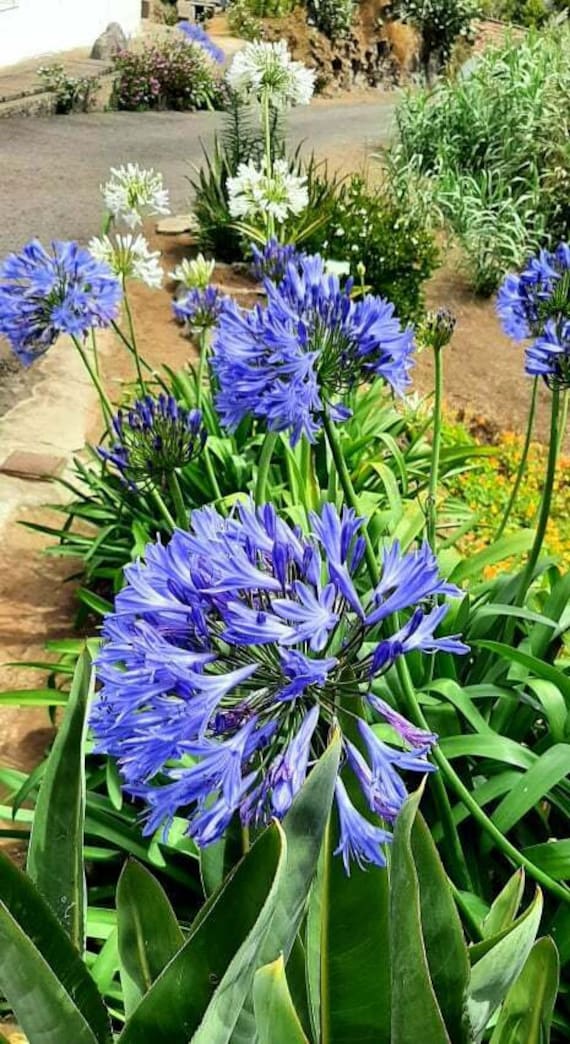Releasing the Secret to Successful Agapanthus Farming: Idea for a Flourishing Garden
In the world of horticulture, cultivating agapanthus effectively calls for a tactical technique that encompasses different aspects of plant treatment. By recognizing the nuances of agapanthus cultivation, one can produce a setting where these plants grow and bloom generously.
Growing Agapanthus: Best Practices
When planting Agapanthus, appropriate soil preparation is necessary for making certain successful growth and development of these stunning blossoms. Agapanthus, generally called Lily of the Nile or African lily, thrives in well-draining soil with a slightly acidic to neutral pH level - Agapanthus. Prior to growing, it is crucial to amend heavy clay dirts with natural issue such as garden compost or peat moss to boost water drainage and offer vital nutrients for the plants
To grow Agapanthus, select a place that gets full sunlight to partial shade, as this will certainly advertise healthy and balanced development and bountiful blooming. Dig a hole twice the diameter of the plant's root ball and place the Agapanthus at the same deepness it was formerly expanding. Delicately backfill the opening with soil, weighing down firmly to remove any air pockets around the roots.
Water the freshly grown Agapanthus extensively and proceed to keep the soil equally wet, specifically throughout the plant's energetic expanding season. Agapanthus. Using a well balanced plant food once a month can additionally sustain the plant's growth and flowering. By adhering to these ideal techniques for growing Agapanthus, you can produce a spectacular display of these captivating blossoms in your yard
Suitable Soil Issues for Agapanthus
For ideal growth and growing success of Agapanthus plants, guaranteeing the dirt conditions are ideal is vital. Agapanthus chooses dirt that is rich in nutrients, so including a balanced plant food during the expanding period can promote healthy and balanced growth and lively blooms.

Watering and Fertilizing Tips
To guarantee healthy growth and vivid blossoms, correct watering and feeding methods are vital for successful Agapanthus cultivation. Agapanthus plants benefit from normal watering, specifically during the growing season.
When it involves feeding Agapanthus, a balanced fertilizer with equal components nitrogen, phosphorus, and potassium can be used in the spring to advertise healthy and balanced development and flowering. Slow-release plant foods are perfect for providing nutrients gradually over an extensive duration. Avoid over-fertilizing, as this can lead to too much vegetation growth at the cost of blossoms.
Furthermore, incorporating natural issue like compost right into the soil can enhance click over here nutrient degrees and enhance dirt framework, aiding in the overall wellness of the Agapanthus plants. By following these watering and feeding ideas, gardeners can guarantee their Agapanthus plants prosper and produce magnificent screens of blossoms.
Pruning and Deadheading Techniques
Correct pruning and deadheading strategies play an essential duty in maintaining the health and appearances of Agapanthus plants, complementing the vital methods of watering and fertilizing for effective farming. Pruning Agapanthus includes getting rid of spent blossom heads, dead or yellowing leaves, and general shaping of the plant to promote much better development. Deadheading, the procedure of getting rid of discolored flowers, not just enhances the plant's look yet likewise urges further growing.
When deadheading Agapanthus, it is advisable to clip off the blossom stem at the content base using sharp, tidy shears. This procedure redirects the plant's power from seed manufacturing back into root and vegetation growth, promoting a much healthier and more robust plant. Routine deadheading can expand the blooming duration of Agapanthus and protect against self-seeding, which can result in overcrowding.
In regards to pruning, Agapanthus normally gain from a light trim see here after flowering to clean up the plant and encourage fresh growth. Cutting down the invested blossom stems and getting rid of any kind of broken or dead vegetation aids maintain the plant's vigor and general appearance. Nonetheless, it is important to avoid cutting right into the crown of the plant, as this can deteriorate its health and wellness.

Protecting Agapanthus From Vermins and Diseases
Carrying out effective bug and disease administration techniques is crucial to safeguarding the wellness and vitality of Agapanthus plants in farming. One common parasite that impacts Agapanthus is the Agapanthus borer, a caterpillar that tunnels right into the plant, triggering damage to the fallen leaves and flowers.
In enhancement to pests, Agapanthus are prone to conditions such as root rot and fungal leaf places. By staying alert and resolving pest and illness problems without delay, gardeners can assist their Agapanthus thrive and prosper.

Conclusion
In verdict, effective cultivation of agapanthus calls for appropriate planting methods, optimal dirt conditions, appropriate watering and feeding, routine trimming and deadheading, and security from bugs and illness. By complying with these ideas and techniques, gardeners can make sure a flourishing yard loaded with attractive agapanthus blossoms. Agapanthus. Bear in mind to preserve constant care and attention to detail to advertise the wellness and long life of these sensational plants
When planting Agapanthus, proper soil prep work is crucial for making sure effective growth and development of these attractive blossoms.Water the recently grown Agapanthus completely and proceed to maintain the soil evenly wet, specifically during the plant's active expanding season.For optimal development and flowering success of Agapanthus plants, making sure the dirt conditions are optimal is critical. When transplanting or growing Agapanthus, make certain the dirt is well-prepared to give the necessary foundation for the plants to develop themselves successfully. One common insect that affects Agapanthus is the Agapanthus borer, a caterpillar that tunnels into the plant, causing damages to the fallen leaves and blossoms.
Comments on “Seasonal Agapanthus Treatment: Planning For Winter Season and Summer”